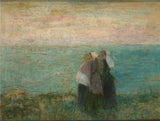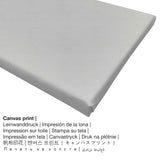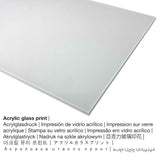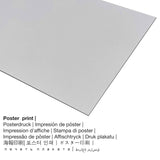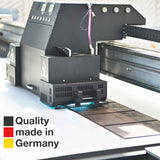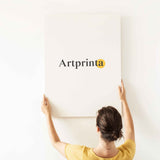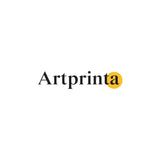Jan Toorop, 1885 - Ụmụ nwanyị nọ n'oké osimiri - mbipụta nka mara mma
Ụtụ gụnyere. Mbupu gbakọrọ na ndenye ọpụpụ.
Họrọ nhọrọ ihe ebipụta nka ịchọrọ
Anyị na-enye ụdị dị iche iche nha na ihe maka ngwaahịa ọ bụla. Ka ị kwekọọ n'ihe ị chọrọ nke ọma, ị nwere ike họrọ n'ime nhọrọ nhazi ngwaahịa ndị a:
- Mbipụta iko acrylic (nke nwere ezigbo mkpuchi iko): An acrylic glass print, often referred to as a plexiglass print, will change the original work of art into magnificient décor. Moreover, the acrylic glass print offers a good alternative option to aluminium or canvas art prints. The artwork is custom-made with the help of state-of-the-art UV direct printing technology. The major benefit of a plexiglass fine art copy is that sharp contrasts and details will be identifiable thanks to the precise tonal gradation of the print. The acrylic glass protects your chosen art replica against sunlight and heat for many decades.
- Aluminom dibond mbipụta (ọla): Aluminium Dibond prints are metal prints with a true effect of depth. For the Direct Aluminium Dibond option, we print the artwork right onto the aluminium surface. The bright & white parts of the artwork shimmer with a silk gloss but without the glare. The print on aluminium is the most popular entry-level product and is an extremely sophisticated way to showcase artworks, as it draws attention on the whole artwork.
- Akwụkwọ mmado ebipụtara (akwa akwa akwa): A poster print is a UV printed flat canvas paper with a slightly rough structure on the surface. Please bear in mind, that depending on the size of the poster print we add a white margin 2-6 cm round about the painting in order to facilitate the framing with your custom frame.
- Kwaaji: The printed canvas stretched on a wooden frame. Canvas prints are relatively low in weight, which implies that it is easy and straightforward to hang up the Canvas print without the support of extra wall-mounts. Hence, canvas prints are suited for any kind of wall.
Nkwupụta iwu: We try everythig possible to depict the art products in as much detail as possible and to display them visually. However, some pigments of the print products and the print result may differ to a certain extent from the representation on the device's monitor. Depending on the screen settings and the quality of the surface, not all colors are printed as realistically as the digital version depicted here. Since all our art prints are processed and printed manually, there might also be minor discrepancies in the motif's size and exact position.
Nkọwa si na ihe ngosi nka (© - site na Rijksmuseum - www.rijksmuseum.nl)
Women at sea. Two women walking with a child in her arms on dunes along the sea.
Nkọwapụta ngwaahịa
Ọ bụ ndị kere ihe osise ahụ Dutch onye na-ese ihe Jan Toorop in 1885. N'oge a, a na-agụnye ọrụ nka na Rijksmuseum's nchịkọta dijitalụ, nke bụ ihe ngosi nka kacha ukwuu maka nka na akụkọ Dutch site na Middle Ages ruo ugbu a. Site n'ikike nke: Rijksmuseum (ikike ngalaba ọha).: . Besides this, the alignment is in landscape format with a side ratio of 4 : 3, meaning that ogologo bụ 33% ogologo karịa obosara. Jan Toorop was a artist, painter, graphic artist, postage stamp designer of Dutch nationality, whose artistic style was primarily Symbolism. The Dutch painter lived for a total of 70 afọ - born in the year 1858 in Purworejo, Jawa Tengah, Indonesia and died in 1928.
Nkọwa gbasara akụkụ nka pụrụ iche
| Aha nka: | "Women at sea" |
| Nhazi nka: | sere |
| Okwu mkpokọta: | nkà nke oge a |
| oge: | 19th narị afọ |
| Emepụtara na: | 1885 |
| Afọ nka: | karịa afọ 130 |
| Ụlọ ihe ngosi nka / ebe: | Rijksmuseum |
| Ebe ngosi nka: | Amsterdam, Netherlands |
| website: | Rijksmuseum |
| Ikikere nke ihe osise: | ngalaba ọha |
| Site n'aka: | Rijksmuseum |
Nkọwa ihe ahaziri ahazi
| Nkewa ngwaahịa: | ọrụ mgbidi |
| Mmeputakwa: | dijitalụ mmeputakwa |
| Production usoro: | mbipụta dijitalụ (Mbipụta UV ozugbo) |
| Ihe ngosi: | German mmepụta |
| Stockdị ngwaahịa: | na mmepụta ihe |
| Eji ngwaahịa a chọrọ: | mkpokọta nka (mmeputakwa), gallery mgbidi |
| Ndozi onyonyo: | nhazi odida obodo |
| Oke akụkụ: | ogologo ruo obosara 4: 3 |
| Oke akụkụ pụtara: | ogologo bụ 33% ogologo karịa obosara |
| Nhọrọ akụrụngwa: | ígwè ebipụta (aluminium dibond), acrylic glass print (nwere ezigbo mkpuchi iko), mbipụta akwụkwọ mmado (akwụkwọ kwaaji), akwụkwọ akwa akwa. |
| Ọdịiche dị n'okirikiri akwa akwa akwa (akwa akwa): | 40x30cm - 16x12", 80x60cm - 31x24", 120x90cm - 47x35", 160x120cm - 63x47" |
| Mpempe iko acrylic (nwere ezigbo mkpuchi iko) nha dị iche iche: | 40x30cm - 16x12", 80x60cm - 31x24", 120x90cm - 47x35", 160x120cm - 63x47" |
| Nhọrọ nke mbipụta akwụkwọ mmado (akwụkwọ kwaaji): | 40x30cm - 16x12", 80x60cm - 31x24", 120x90cm - 47x35" |
| Mbipụta aluminom: | 40x30cm - 16x12", 80x60cm - 31x24", 120x90cm - 47x35" |
| Nhazi mmeputa nka nka: | oyiri nka na-enweghị isi |
Ozi omenka
| Aha onye nka: | Jan Toorop |
| Aliases: | Toorop Jan Theodoor, Toorop Jan, Jan Theodoor Toorop, Toorop Jean Theodoor, Jan Toorop, Toorop Jean Theodoro, טורופ יאן, Jean Theodoor Toorop, Johannes Theodorus Toorop |
| Gender: | nwoke |
| Obodo onye nka: | Dutch |
| Ọrụ onye na-ese ihe: | painter, artist, postage stamp designer, graphic artist |
| Country: | mba netherland |
| Nhazi nke onye nka: | omenkà nke oge a |
| Ụdị nke onye na-ese ihe: | Akara |
| Ndụ: | 70 afọ |
| Afọ amụrụ: | 1858 |
| Ebe omuma: | Purworejo, Jawa Tengah, Indonesia |
| Nwuru: | 1928 |
| Ebe ọnwụ: | Hague, The, South Holland, Netherlands |
Nwebiisinka © | Artprinta.com (Artprinta)

